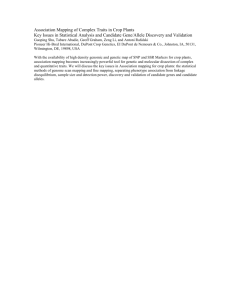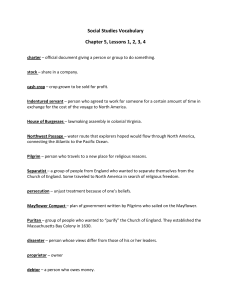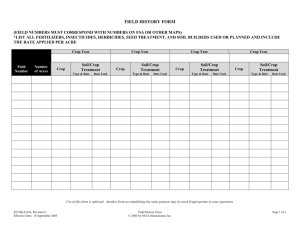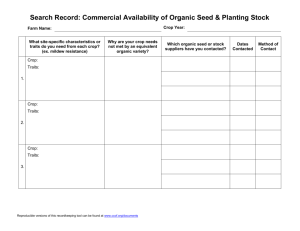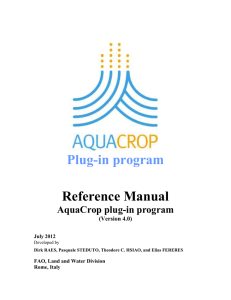A MODEL BASED APPROACH TOWARDS ENVIRONMENT
advertisement
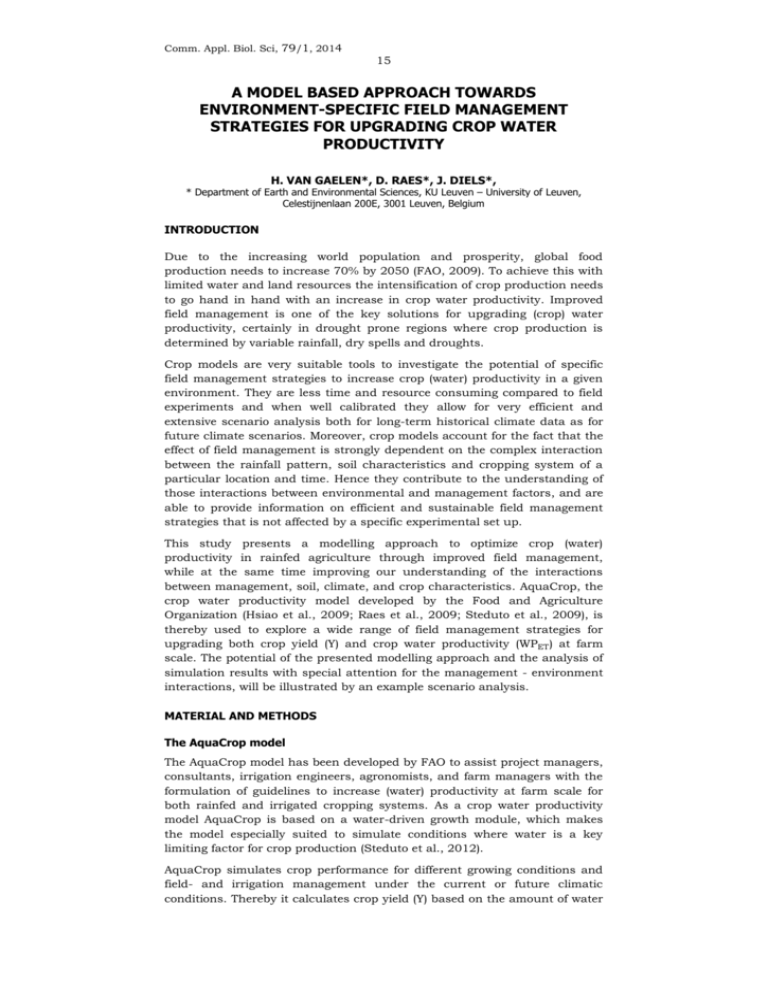
Comm. Appl. Biol. Sci, 79/1, 2014 15 A MODEL BASED APPROACH TOWARDS ENVIRONMENT-SPECIFIC FIELD MANAGEMENT STRATEGIES FOR UPGRADING CROP WATER PRODUCTIVITY H. VAN GAELEN*, D. RAES*, J. DIELS*, * Department of Earth and Environmental Sciences, KU Leuven – University of Leuven, Celestijnenlaan 200E, 3001 Leuven, Belgium INTRODUCTION Due to the increasing world population and prosperity, global food production needs to increase 70% by 2050 (FAO, 2009). To achieve this with limited water and land resources the intensification of crop production needs to go hand in hand with an increase in crop water productivity. Improved field management is one of the key solutions for upgrading (crop) water productivity, certainly in drought prone regions where crop production is determined by variable rainfall, dry spells and droughts. Crop models are very suitable tools to investigate the potential of specific field management strategies to increase crop (water) productivity in a given environment. They are less time and resource consuming compared to field experiments and when well calibrated they allow for very efficient and extensive scenario analysis both for long-term historical climate data as for future climate scenarios. Moreover, crop models account for the fact that the effect of field management is strongly dependent on the complex interaction between the rainfall pattern, soil characteristics and cropping system of a particular location and time. Hence they contribute to the understanding of those interactions between environmental and management factors, and are able to provide information on efficient and sustainable field management strategies that is not affected by a specific experimental set up. This study presents a modelling approach to optimize crop (water) productivity in rainfed agriculture through improved field management, while at the same time improving our understanding of the interactions between management, soil, climate, and crop characteristics. AquaCrop, the crop water productivity model developed by the Food and Agriculture Organization (Hsiao et al., 2009; Raes et al., 2009; Steduto et al., 2009), is thereby used to explore a wide range of field management strategies for upgrading both crop yield (Y) and crop water productivity ( ) at farm scale. The potential of the presented modelling approach and the analysis of simulation results with special attention for the management - environment interactions, will be illustrated by an example scenario analysis. MATERIAL AND METHODS The AquaCrop model The AquaCrop model has been developed by FAO to assist project managers, consultants, irrigation engineers, agronomists, and farm managers with the formulation of guidelines to increase (water) productivity at farm scale for both rainfed and irrigated cropping systems. As a crop water productivity model AquaCrop is based on a water-driven growth module, which makes the model especially suited to simulate conditions where water is a key limiting factor for crop production (Steduto et al., 2012). AquaCrop simulates crop performance for different growing conditions and field- and irrigation management under the current or future climatic conditions. Thereby it calculates crop yield (Y) based on the amount of water 16 transpired by the crop (Tr). Tr depends on the climatic conditions as well as the green canopy cover of the crop. Tr is converted into dry aboveground biomass production, which in its turn is related to Y through the harvest index (HI). The crop water productivity ( ) is calculated as the ratio of Y to the total amount of water evapotranspired by the crop throughout the growing season (ET) and expressed as kg marketable yield per water evapotranspired. During simulation canopy and root development, Tr and HI are affected by water stress which is determined by means of a soil water balance keeping track of daily incoming (rainfall, irrigation and capillary rise) and outgoing (runoff, deep percolation and evapotranspiration) water fluxes. The soil water balance is the most important feature in the AquaCrop calculation procedure, as it is the point where the interaction between soil characteristics, crop development, root development, climate and management aspects takes place. AquaCrop moreover accounts for the effect of soil fertility stress, soil salinity stress and air temperature stress on crop production. Developed as a decision support tool, the AquaCrop calculation procedure also accounts for the effect of irrigation and field management. Field management practices implemented in AquaCrop version 4.0 (Raes et al., 2012) include soil fertility management (affecting crop canopy development and biomass production), mulches (affecting soil evaporation), field surface practices (tillage and soil bunds affecting the soil surface storage and runoff) and soil structure management (a restrictive soil layer affecting the root zone expansion and other practices that affect infiltration and the root zone water reservoir). Although not (yet) explicitly implemented, also rainwater harvesting (ex-situ or runoff agriculture affecting the soil water balance) and weed management (affecting canopy development) can be simulated with the current AquaCrop version as explained by Van Gaelen (2012). Simulation experiment To illustrate the AquaCrop modelling approach, a factorial simulation experiment, consisting of 729 AquaCrop simulations, was carried out assessing the effect of field management practices on Y and for a wide range of rainfed farming systems. A combination of 3 climates (subhumid Chitedze (Malawi), semi-arid Mekelle (Ethiopia), semi-arid Tunis (Tunisia)), 3 crop cycle lengths of barley (short, medium and long), 3 soil types (loamy sand, silt, clay loam) and 3 soil fertility levels (non-limiting, moderate, poor) represented 81 different rainfed farming systems. For each of these 81 farming systems 9 field management practices were considered next to a reference simulation: 2 levels of mulch cover (M50 & M95), 2 levels of weed infestation (W15 & W30), the presence of soil bunds (Bunds), the occurence of a restrictive soil layer (Restr), an increase (TAW+) and decrease (TAW-) of the total available soil water, and the introduction of runoff agriculture (RWH). Every simulation consisted of 30 (Chitedze and Mekelle) or 23 (Tunis) growing seasons. The simulated seasons were classified as dry, normal or wet based on a frequency analysis of the seasonal rainfall of the total time series. The effectiveness of a field management practice was expressed by means of the Y and response. These response values express the relative increase (positive response values) or decrease (negative response values) of the average productivity (Y or ) under certain environmental conditions due to a specific field management in comparison to the reference field management. Comm. Appl. Biol. Sci, 79/1, 2014 17 RESULTS The average Y and response to the 9 different field management strategies is depicted in Fig. 1 for different combinations of climate and seasonal rainfall ranging from very dry in the lower right corner to more wet in the upper left corner. The way results are presented in Fig. 1 enables to gain a clear understanding of the general effect of each of the 9 management strategies. First, the four quadrants in every plot of Fig. 1 easily distinguish the four possible effects of a specific strategy. The origin (0,0) represents the reference treatment (no response). The situations where both Y and decrease or increase are displayed in the lower left quadrant (III) and upper right quadrant (I) respectively. In quadrant I one can easily distinguish the practices that not only increase Y but also limit the unproductive water losses since their data points are located above the 1:1 line (Ia). For example mulches save a lot of water by reducing evaporation, leading to responses in quadrant Ia. No points are located in quadrant IV, as it represents strategies that increase Y while decreasing , which is not a realistic situation for rainfed farming. Finally, quadrant II represents the situations where despite a decrease in Y, an increase of is observed. For implementation of those practices the importance of saving water has to be weighed against the yield decline. Second, Fig. 1 proves that the effectiveness of certain strategies is highly determined by the weather conditions. On the one hand, it can be observed that in the driest conditions none of the investigated practices are very effective to increase Y. In slightly more humid conditions water saving practices like mulches, rainwater harvesting and bunds are most effective. By contrast, in the most humid conditions those water saving practices become less effective. Fig. 1 also shows that mulching and weed control pays off under all weather conditions. Third, Fig. 1. also reveals some unexpected effects of field management strategies. For example Restr, TAW- and TAW+ do not affect Y and as one would expect by their ability to decrease or increase water availability. By revealing such unexpected results, experimental research could better target to those specific issues. Fig. 1 gives a good indication on which strategies would increase the average Y and under different environmental conditions. However, additional analysis of the effect of field management on the incidence of complete harvest failure (Y=0 ton/ha) is also advisable, certainly for dry regions with variable rainfall. For dry seasons in Mekelle such an analysis (Fig. 2) reveals that the water saving practices that were most beneficial for Y and (Bunds, RWH, M50, M95) (Fig 1.) also decrease the occurrence of crop failure. Inadequate weed management on the other hand decreases Y and substantially in dry seasons in Mekelle (Fig 1.) but does not affect the occurrence of crop failure. Moreover Fig 2. reveals that the outcome of a management strategy with regard to harvest failure is highly dependent on the soil type on which the strategy is applied. 18 II Ia Ib III IV Figure 1. Average yield (Y) and crop water productivity response to different field management strategies i.e. TAW- (), TAW+ (), Restr (), Bunds (), M50 (), M95 (), RWH (), W15 (), W30 () for different climatic conditions. Figure 2. The average occurrence of complete harvest failure (Y= 0 ton/ha) during dry growing seasons in Mekelle on clay loam (grey dot), loamy sand (black dot) and silt (white dot) soils under different field management strategies. The lines indicate the percentage of harvest failure under the reference field management. Comm. Appl. Biol. Sci, 79/1, 2014 19 DISCUSSION This research illustrated how the AquaCrop modelling approach can be used to investigate the effect of various field management practices and how the simulation results can be analyzed and presented to gain a clear picture on the potential of different strategies for upgrading (water) productivity under different environmental conditions. Hence, it was by no means intended to present the optimal field management strategies for the simulated regions. The presented response values should be seen as indicative and a useful tool for comparison of the effect of field management practices and for exploration of the interaction between management and environmental variables. Due to the strong interaction between management, crop, soil and climate, clearly field management strategies should be tailored to the specific local environment and farming conditions. Assessment of strategies by AquaCrop for local conditions should always be complemented with field experiments. Field management practices that show high potential in explorative simulations can be tested in experimental fields. Those field experiments can also serve to calibrate the AquaCrop model for the local farming conditions in order to improve the accuracy of simulation results. Even though management decisions are to be customized for every specific location, the AquaCrop modelling approach still leans itself for guideline development and scenario analysis on a large spatial scale. For that purpose AquaCrop can be coupled to a GIS system (e.g. AquaGIS by Lorite et al. (2013)). Further, as indicated by this research, strategic decisions regarding field management require many simulation runs for a long series of (historical) climate data (preferably at least 30 years). Not only the interaction between field management and climatic conditions can be studied more carefully in that manner, but also the effect of field management on yield stability can be analyzed. The user-friendly interface, small calculation time, project modus and standalone version of AquaCrop make the model very suitable to conduct such a long-term scenario analysis. In addition the AquaData tool (Lorite et al., 2013) can facilitate input and output data processing. Although the proposed modelling approach provides very valuable insights, it is of no avail if the effects of the improved field management practices are not understood by the farmers, and the practices not correctly implemented. For this reason the importance of a well functioning extension system cannot be stressed enough. The proposed modelling approach significantly contributes to a better understanding of the effects of field management practices and to a more successful transfer of the research results to the local farmers. First of all, the AquaCrop software is developed by keeping a good balance between accuracy and simplicity so that it can be used by practical end-users like extension agents and project managers. That way analysis of new strategies can be conducted by the people who are most familiar with the specific environmental and socio-economic farming conditions. Second, figures like presented in this paper (Fig. 1-2) could be useful starting points for discussions with the local farming community and further research. The most promising strategies can be implemented at demonstration fields or further evaluated from an institutional and socioeconomic point of view. With the proposed modelling approach more sustainable decisions regarding field management can be achieved for two reasons. First, AquaCrop simulation results not only show how management affects Y but also how is affected. Since water is or is becoming a bottleneck in many regions of the world, field management decisions should not just be based on profit 20 in grain yield but also on the efficiency with which water is used. Second, with AquaCrop future climatic conditions and their effect on crop production can also be taken into account. A scenario analysis of field management strategies for both current and future climatic conditions could help to select strategies that are not only effective under current environmental conditions, but will remain effective in the future as well. CONCLUSION The AquaCrop modelling approach presented and illustrated in this paper appears to be very practical, powerful and efficient to evaluate a broad range of field management strategies for upgrading crop (water) productivity in rainfed dryland farming, and to tailor these management strategies to the specific farming system and environmental conditions. The key advantage of the proposed approach is that AquaCrop enables studying the effect of different field management practices on grain yield and crop water productivity at the same time. This makes the approach very suitable for regions where water availability is limited or is likely to become a bottleneck for increasing agricultural productivity. Moreover, the proposed modelling approach leads to more sustainable decisions as it is able to account for the complex interaction between management, soil and crop characteristics, soil fertility levels, and current or future climatic conditions. Finally, also the wide-ranging applicability, the user-friendly software interface, the low input requirements, the transparent calculation procedure and small calculation time together with the ability to combine the model with additional tools make AquaCrop an excellent decision support tool for extensive field management scenario analysis. ACKNOWLEDGEMENTS This research was funded by the Research Foundation – Flanders (FWO) and awarded the Ernest du Bois grant for research on the theme of water and its availability on world scale. REFERENCES FAO (2009). High-Level Expert Forum: How to feed the world in 2050. FAO, Rome, Italy, 35 pp. Hsiao, T.C., Heng, L., Steduto, P., Rojas-Lara, B., Raes, D., Fereres, E. (2009). AquaCrop—The FAO crop model to simulate yield response to water: III. Parameterization and testing for maize. Agron. J. 101: 448–459. Lorite, I.J., García-Vila, M., Santos, C., Ruiz-Ramos, M., Fereres, E. (2013). AquaData and AquaGIS: Two computer utilities for temporal and spatial simulations of water-limited yield with AquaCrop. Comp. Electron. Agr. 96: 227–237. Raes, D., Steduto, P., Hsiao, T.C., Fereres, E. (2009). AquaCrop—The FAO crop model to simulate yield response to water: II. Main algorithms and software description. Agron. J. 101: 438–447. Raes, D., Steduto, P., Hsiao, T.C., Fereres, E. (2012). AquaCrop Reference Manual, AquaCrop version 4.0. FAO, Rome, Italy. Steduto, P., Hsiao, T.C., Raes, D., Fereres, E. (2009). AquaCrop—The FAO crop model to simulate yield response to water: I. Concepts and underlying principles. Agron. J. 101: 426-437. Steduto, P., Hsiao, T.C., Fereres, E., Raes, D. (2012). Crop yield response to water. FAO irrigation and drainage paper No.66. FAO, Rome, Italy, 516 pp. Van Gaelen, H. (2012). The effect of field management on yield and water productivity. Master thesis, KU Leuven University, Leuven, Belgium, 90 pp.


